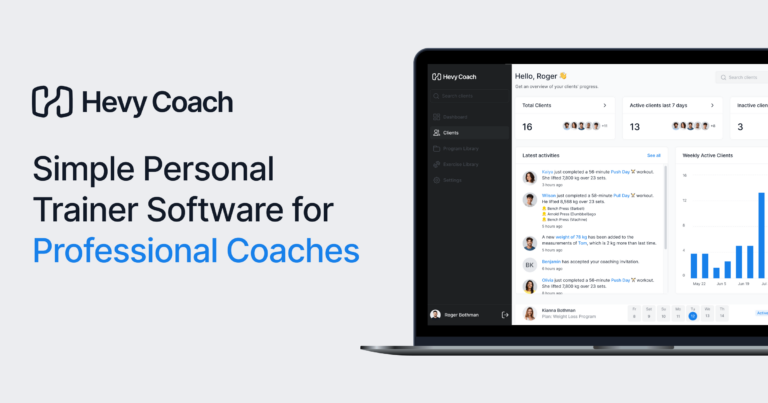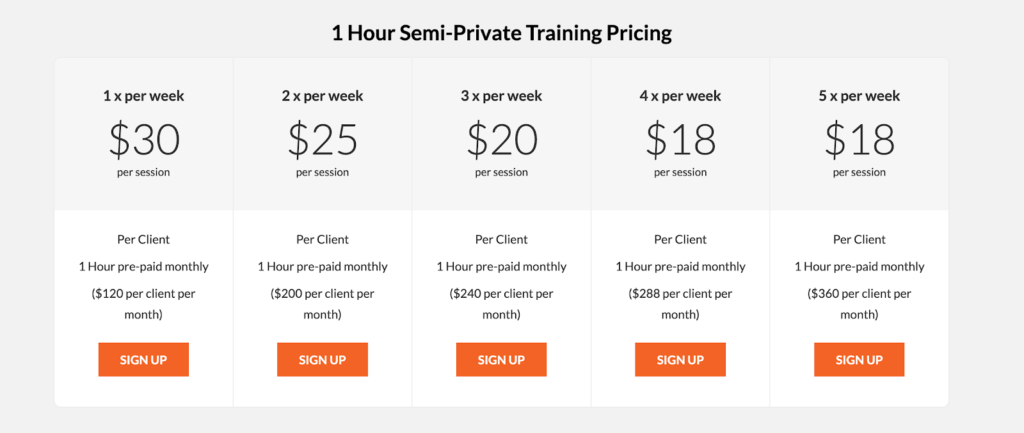Despite the popularity of group classes and fitness courses, personal training is the gold standard for guiding people on their training journey.
A good personal trainer provides effective workout plans, helps trainees improve their technique, teaches clients how hard to train, and does countless other things. Put simply, clients get a ton of value from every session.
As a personal trainer, one of the primary things you probably worry about is how much you should charge. After all, you want good earnings, but you also want your rates to be reasonable.
Read on because we are breaking it all down today: what factors to consider, how to determine your rates, and how much to charge people for online coaching.
Factors to Consider When Setting Personal Training Service Rates
1. Experience and Qualifications
Experience and qualifications are two crucial factors that determine the personal trainer cost.
A personal trainer who has coached hundreds or thousands of people can leverage their reputation to charge more. Similarly, having more qualifications could make a trainer more valuable to clients.
For instance, an NSCA certification means a personal trainer has invested more in their formal education and is, therefore, more likely to have the skills and experience to help clients. As such, they could earn more from each training session.

2. Location and Competition
Location and competition are two other crucial factors to consider. You could be an excellent coach with impressive qualifications, but if you offer in-person training, you must look at local personal trainers and how much they charge per hour or session.
3. The Type of Service You Offer
Offering private sessions means you can charge hourly or per workout and earn more.
Semi-private coaching is also viable, especially for part-time personal trainers and those with large client rosters. Instead of working with one person, you work with up to four clients at a time.
You can’t charge as much per client, but even lower rates add up when you get paid to coach two, three, or four people.
Group fitness instructors tend to earn an hourly wage or a flat rate per class, depending on the training facility. Great instructors can also negotiate a commission on top of their salary.
Finally, we arrive at online trainers, who typically work for a monthly fee. The earnings potential per client is smaller than in-person coaching, but so is the time commitment.
Instead of investing several hours per week, an online trainer provides a plan and generally checks in once a week to see how things are going. Having five to ten dedicated clients could mean significant monthly earnings.
While on the topic, check out Hevy Coach––the all-in-one platform for personal trainers and coaches to communicate with their clients, track their progress, assign workouts, and make changes on the go.

Try Hevy Coach
Intuitive personal trainer software, with a world class experience for your clients.
30 day free trial, no credit card required
4. Client Demographics
Your client demographic and target market also affect how much you can earn. For example, you can command higher rates if your niche is elderly people in Beverly Hills.
What are the Average Personal Training Rates in 2024?
As of 2024, the average hourly rate is $55-60 in the United States. The lowest hourly rate is $40, and the maximum is $100, though there are exceptions depending on location, target market, type of personal training, and the place of employment.
For example, the average personal trainer rate is $60 for LA Fitness and $75 for a one-hour session at Gold’s Gym. Lifetime Fitness rates per hour can be as high as $110.
Group fitness classes typically cost $35 per session per person. However, it’s worth noting that some gyms, including Planet Fitness, Equinox, and Lifetime Fitness, offer free group classes for people with a membership.
Semi-private personal training is also a desirable option. Despite earning less from each client, you can work with several people at a time and make up the difference that way.
For example, here’s what Republic Warrior Sports offers:

At $30 per person, you can earn up to $120 when coaching four people together. Even if the person commits to four or five weekly workouts, $18 per person can net you $72 per hour. The advantage of the latter option is that you’re guaranteed more work and greater earnings.
Across the pond, some sources suggest that the average UK personal training rates are £40 to £60 per hour. Like in the US, multiple factors, including location, qualifications, and the type of service offered, play a role in the equation.
For instance, moving from London to a rural area would mean having to charge much less per session to retain enough clients.
How Much to Charge for Personal Training Sessions?
The numbers in the previous point should have given you some idea, so let’s now go over a few important considerations:
1. Where Do You Stand As a Personal Trainer?
The first thing you should do is take an objective look at where you stand to determine how much you can realistically charge clients.
It would be great to see what the top personal trainers in your area charge and do the same, but that rarely works out well. You need to establish yourself as a good personal trainer and build a resume before you can reach that point.
Here are a few things to consider:
- Qualifications – are you a certified personal trainer?
- Experience – how long have you been in the game, and have you coached enough people?
- Specializations – have you completed additional courses to specialize in different areas to serve your clients better?
- Reputation – do you have one? Do people in your area know who you are and trust that you can help them?
- Testimonials – do you have an extensive list of past clients who have put together testimonials, telling everyone how good of a personal trainer you are?
2. Who is Your Target Demographic?
Carving out a niche for yourself is an excellent way to gain experience and help people with specific needs. It also lets you narrow your marketing efforts and learn about prospective clients’ struggles.
In addition to signing more clients, you can come up with things that set you apart from many of your competitors. Too many personal trainers try to serve everyone only to blend with the crowd and go unnoticed.
Being known as the guy or gal for people in a specific situation instantly makes you different because people recognize that you specialize in one or two key areas. People dealing with a particular problem would be more likely to contact you instead of working with a generic personal trainer.
Having a niche is also an excellent way to determine your rates. For instance, working with elderly people from a wealthy suburb would mean you can command higher rates. In contrast, working with younger people, especially college students with a part-time job, would force you to lower your rates.
3. Where Are You Located?
An online personal trainer doesn’t have to worry about location because they can work with clients worldwide. Unfortunately, that’s not the case for in-person coaching.
Regardless of your experience, credentials, and reputation, you must look at what your competition is doing to determine your rates. For example, you can command higher personal trainer rates in a large city, but you would have to adjust accordingly if you live in a small town.
Aside from looking at your competition to determine your rates, you should find areas for improvement in the type of service they offer and their marketing message. That way, you can develop a unique value proposition (UVP)––the thing that sets you apart from everyone else.
4. What Type Of Service Do You Offer?
How can you help your personal training clients? Do you offer one-on-one coaching and spend each session helping your client improve, or do you lean more toward group training?

Additionally, do you have qualifications or experience you can use to help people deal with specific issues, or are you more likely to immediately send them to a physiotherapist at the first sign of trouble?
Beyond training, can you help clients reach their fitness goals by providing nutritional recommendations or an eating plan?
The more you can help clients, the more you can earn.
5. What Pricing Model Do You Want to Use?
Most fitness professionals start with the classic model of charging per session, which can work well enough. Fortunately, you don’t have to limit yourself to that, as there are plenty of opportunities to make your services more desirable.
For instance, offering packages is a great way to earn good money and retain clients. One option is to provide a discount for every five training sessions purchased. Buy five sessions and get a 20 percent discount.
Alternatively, offer more support for clients willing to commit beyond the first session. For example, if a client purchases a monthly package, throw a nutritional plan for free or at a considerable discount.
Another option is making personal trainer assessments free for your regular clients. These should occur every few weeks and generally take 30 to 45 minutes. The upside is that your clients also get to see their progress in the last few weeks, which can be motivating.
How Much to Charge for Online Personal Training
Determining your rates as an online personal trainer is perhaps slightly easier because there are a couple of things you don’t have to worry about––most notably, location.
Still, here are a few things to consider:
1. Pricing Model & Service Offered
Your pricing model plays a considerable role in determining your rates as an online coach.
Traditionally, online coaches request a monthly subscription and a commitment for at least three months. After that, depending on what you offer (more on that in a moment), you can charge anywhere from $100 to $500+ per month.
Charging per session is also an option, especially if your clients exercise at home and you can see them train in real time. Your rate should be lower than in-person coaching simply because you couldn’t help clients to the same degree on video calls.
If the average hourly rate is $55 to 60, you could charge 20 to 40 percent less for online sessions.
Providing customized plans to clients is the least ‘hands-on’ option, and one many personal trainers prefer. There are some significant drawbacks to that approach, but that is beyond the scope of today’s article.
Depending on the type and duration, personalized plans can run from as little as $20 to as much as $100+. For example, a 12-week training plan with built-in progression, flexibility, and de-loading can cost $80-100 or more if it comes with ongoing support, scheduled calls, and other extras.
Related article: How Much to Charge for a Workout Plan? Here’s How to Decide
2. Target Audience
As with in-person coaching, your target audience will affect your rates online. The issue is that determining how much money your target audience can spend is tricky. It is best to experiment with pricing to see what works best.
For example, a coach targeting older adults will generally be able to charge more than someone primarily working with college-aged people. Similarly, women in their early fifties might be able to spend more money to work with a certified personal trainer than new moms.
People generally earn more as they get older, but there are always exceptions.
Start managing your clients’ workouts like a pro with Hevy Coach. The platform makes it effortless to stay on top of things, communicate with each client, assign workouts, and lots more!
3. Your Reputation
When determining your personal trainer rates online, the third thing to consider is your reputation. Are you brand new and still trying to land your first five clients, or are you an established online coach with dozens of testimonials?
For example, Andy Morgan from RippedBody.com has been around for a long time and has coached many people. As you can see from his coaching services page, there are countless testimonials from happy clients.
Because of his reputation, he can charge more and earn a great living. Someone new and relatively inexperienced would be better off offering more affordable services to get the ball rolling.
The good news is that online coaching is far more flexible, and trainers can often work with 10, 20, or even 30+ people, which means the earnings potential is enormous, even with lower rates.

Try Hevy Coach
Intuitive personal trainer software, with a world class experience for your clients.
30 day free trial, no credit card required
4. Your Reach
Reach refers to the number of people who see your content online and affects your ability to land new clients.
Have you established your presence online? Here are a few questions to consider:
- Do you have an engaged following on social media?
- Do you run a thriving YouTube channel that reaches thousands or millions of people every month?
- Is your blog getting decent traffic and ranking well on Google?
- Do you have an email list? If so, how many active subscribers are on it?
People with good reach have access to more people and can charge more. Here’s a simple example of how reach influences an online coaching business.
John has a successful blog and 100,000 mostly active email subscribers on his list. His emails have an average open rate of 40 percent, meaning roughly 40,000 people read every email he sends.
If he sends an email promoting his online services, even a 0.1 percent conversion rate would mean signing 40 new clients.
In contrast, someone with a list of 1,000 can expect 350 to 400 subscribers to read each email. If the conversion rate is the same, the person is unlikely to sign anyone as a client through a single email.
Related article: How to Advertise Myself as a Personal Trainer? (4 Key Areas to Focus On)
How Much Do Personal Trainers Make?
According to indeed.com, the average personal trainer salary in the US is $27,81 per hour, which comes out to a bit over $45,000 a year. The pay varies, depending on where the personal trainer works and who employs them.
For instance, according to the same source, the average hourly salary is $25,21 in Houston but $43,69 in Washington. Similarly, City Sports Club and Orangetheory Fitness offer some of the highest hourly wages of $40+.
Over in the UK, the average annual base salary for personal trainers is £29,837.
Data from Australia suggests that personal trainers earn just over $83,000 per year, roughly the same as in the US when converted.
The good thing about personal training is that it doesn’t have to be a full-time job, especially at first. Acquiring a trainer certification allows you to explore the career path through a part-time position and earn additional income.
Conclusion
Personal training continues to be an excellent way for fitness enthusiasts to get started and establish a base.
When establishing your rates, the primary factors to consider are your experience, qualifications, the type of services you offer, target audience, competition, and location.
As of 202r, the average rate in the US is $55-60 per hour, and personal trainers can expect to earn a base salary of $45,000 per year. Of course, there are exceptions to the rule, and location appears to have the most significant impact on a trainer’s earnings potential.
Those interested in offering their services online should determine their rates by considering the type of service they offer, their target audience, reputation, and reach.
It is best to experiment to see what works best in your situation. You can adjust your rates once you’ve received feedback from clients and folks interested in your services.
With that said, managing your clients and providing the best training programs is crucial for keeping them happy and maintaining a high retention rate.
Check out Hevy Coach––the platform that will revolutionize how you interact with clients, track their progress, assign workouts, and make changes to their training plans.




